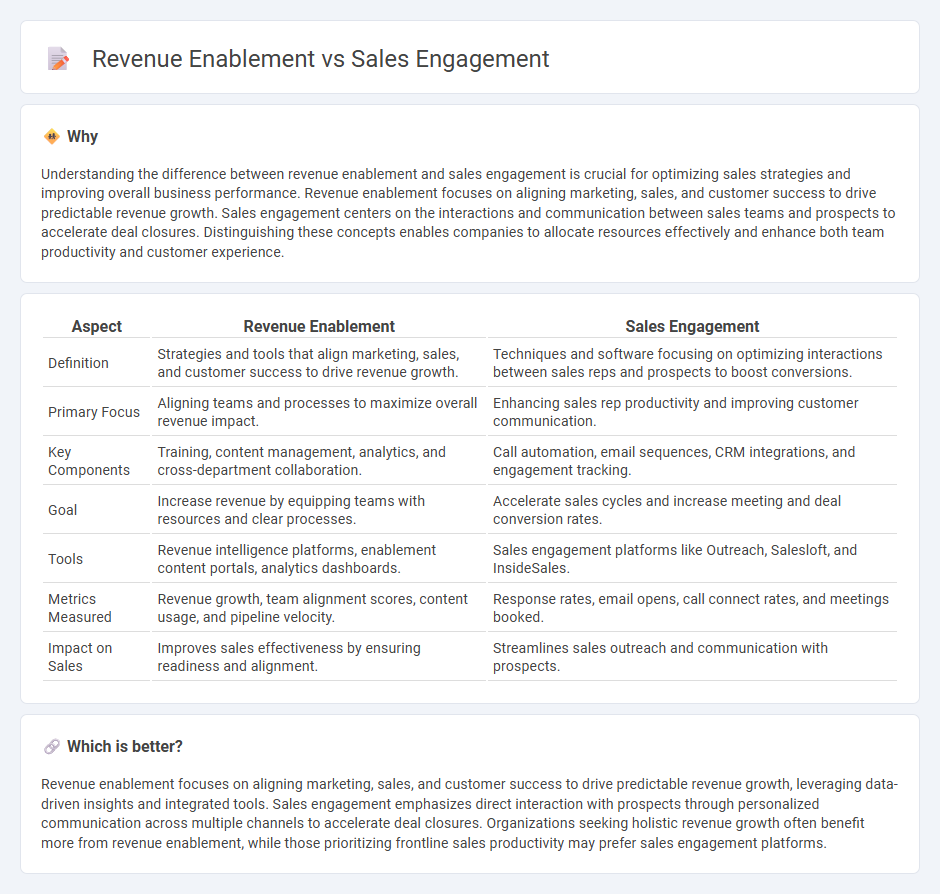
Revenue enablement focuses on aligning sales content, tools, and training to accelerate the customer buying process and increase deal velocity. Sales engagement emphasizes direct interactions between sales reps and prospects through personalized communication and multi-channel outreach to boost conversion rates. Explore the differences between revenue enablement and sales engagement to optimize your sales strategy.
Why it is important
Understanding the difference between revenue enablement and sales engagement is crucial for optimizing sales strategies and improving overall business performance. Revenue enablement focuses on aligning marketing, sales, and customer success to drive predictable revenue growth. Sales engagement centers on the interactions and communication between sales teams and prospects to accelerate deal closures. Distinguishing these concepts enables companies to allocate resources effectively and enhance both team productivity and customer experience.
Comparison Table
| Aspect | Revenue Enablement | Sales Engagement |
|---|---|---|
| Definition | Strategies and tools that align marketing, sales, and customer success to drive revenue growth. | Techniques and software focusing on optimizing interactions between sales reps and prospects to boost conversions. |
| Primary Focus | Aligning teams and processes to maximize overall revenue impact. | Enhancing sales rep productivity and improving customer communication. |
| Key Components | Training, content management, analytics, and cross-department collaboration. | Call automation, email sequences, CRM integrations, and engagement tracking. |
| Goal | Increase revenue by equipping teams with resources and clear processes. | Accelerate sales cycles and increase meeting and deal conversion rates. |
| Tools | Revenue intelligence platforms, enablement content portals, analytics dashboards. | Sales engagement platforms like Outreach, Salesloft, and InsideSales. |
| Metrics Measured | Revenue growth, team alignment scores, content usage, and pipeline velocity. | Response rates, email opens, call connect rates, and meetings booked. |
| Impact on Sales | Improves sales effectiveness by ensuring readiness and alignment. | Streamlines sales outreach and communication with prospects. |
Which is better?
Revenue enablement focuses on aligning marketing, sales, and customer success to drive predictable revenue growth, leveraging data-driven insights and integrated tools. Sales engagement emphasizes direct interaction with prospects through personalized communication across multiple channels to accelerate deal closures. Organizations seeking holistic revenue growth often benefit more from revenue enablement, while those prioritizing frontline sales productivity may prefer sales engagement platforms.
Connection
Revenue enablement integrates tools, training, and analytics to empower sales teams, directly enhancing sales engagement by providing personalized, timely content and insights. Sales engagement platforms facilitate real-time interactions, tracking buyer behaviors and optimizing communication strategies, which align with revenue enablement goals to accelerate deal closures. The synergy between revenue enablement and sales engagement drives higher conversion rates, improved pipeline velocity, and consistent revenue growth.
Key Terms
Outreach (Sales Engagement)
Outreach, a leading sales engagement platform, streamlines communication workflows and automates personalized outreach to boost sales productivity and pipeline velocity. Unlike revenue enablement, which broadly encompasses strategies to align sales, marketing, and customer success for revenue growth, sales engagement platforms like Outreach specifically focus on optimizing direct customer interactions through multi-channel campaigns and analytics. Discover how leveraging Outreach can transform your sales team's engagement and close rates by exploring its comprehensive features.
Buyer Journey (Revenue Enablement)
Sales engagement concentrates on direct interactions with prospects, optimizing touchpoints to drive immediate conversions and pipeline acceleration. Revenue enablement takes a broader approach, aligning content, tools, and training across marketing, sales, and customer success teams to support the entire buyer journey from awareness to post-sale growth. Explore how integrating revenue enablement strategies can elevate your buyer-centric approach and maximize revenue impact.
Metrics Alignment
Sales engagement emphasizes improving communication interactions and tracking metrics such as call frequency, email response rates, and meeting conversions to drive sales productivity. Revenue enablement centers on aligning marketing, sales, and customer success teams with unified metrics like customer lifetime value (CLV), sales velocity, and pipeline acceleration to optimize overall revenue growth. Explore deeper insights on how metrics alignment between sales engagement and revenue enablement can transform your business outcomes.
Source and External Links
What Is Sales Engagement? A Complete Guide for ... - Sales engagement describes all interactions between salespeople and prospects throughout the sales cycle, focusing on building meaningful connections that improve conversion, retention, and revenue performance by tailoring the approach to customer needs.
Sales engagement: How to best connect with buyers - A sales engagement strategy is essential for meeting buyer expectations by ensuring timely, relevant, and multichannel communication that improves conversion rates through tools, training, and continuous iteration of sales interactions.
Sales Engagement: The Definitive Guide for Platform ... - Sales engagement platforms unify the planning, execution, tracking, and optimization of high-quality interactions with buyers, enabling sales teams to scale engagement and improve conversion rates and deal sizes, which has become a top priority for sales leaders.
 dowidth.com
dowidth.com